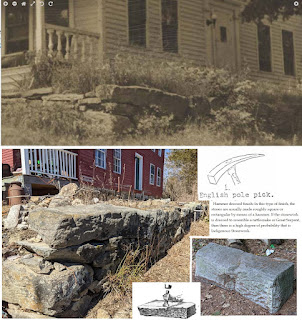Saturday, October 23, 2021
Serpent Stacking (CT)
Saturday, October 09, 2021
Columbus didn't discover America?
[not rock pile related]
It seems likely to me, that Basque fishermen knew about America, long before even the above documentation.
Yay for Indigenous People's Day!
Friday, October 08, 2021
Large Stone Tool from the Woods Hole beach
Continuing a series of implausible stone tool types: I see deliberate flaking on rocks, regardless of the size of the rock. Often enough, a large rock has been flaked, presumably because the removed flake was useful. But here are examples of what is called "hinge flaking" that are coordinated with each other, suggesting that, rather than being a source for material, here the entire large rock was a tool.
Now look at the edge:This is a comparatively soft material.This rock was on Devil's Foot island. I have found a couple others like this before, on the stretch of cobbles north of little Gansett beach. It leads to the question of what would large chopping tools be for, when used on a beach?






